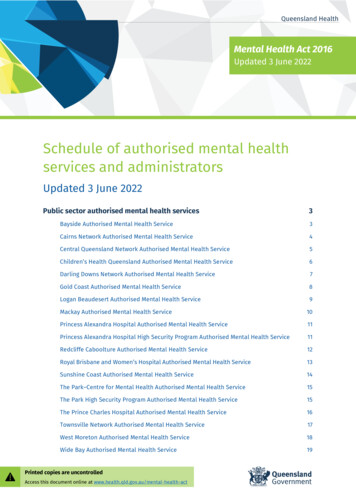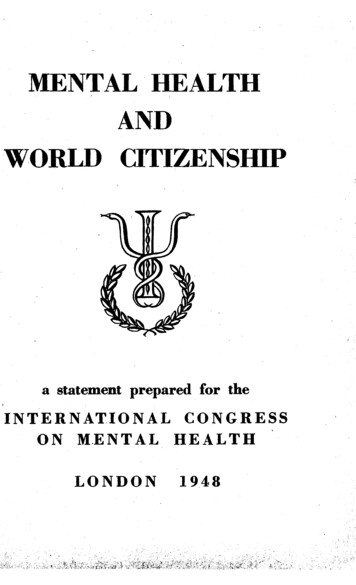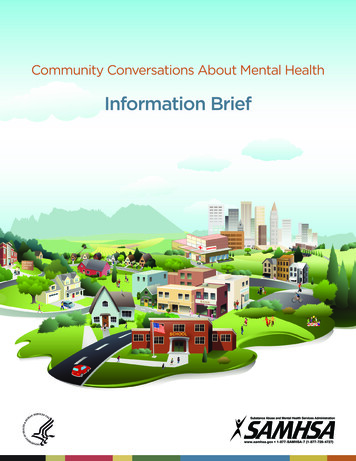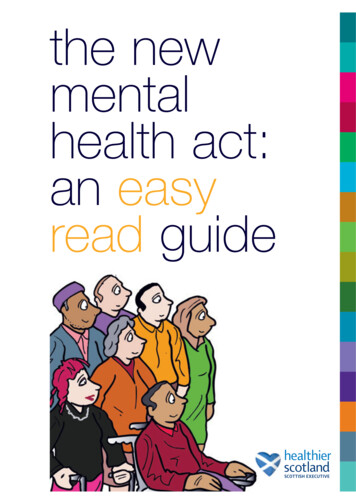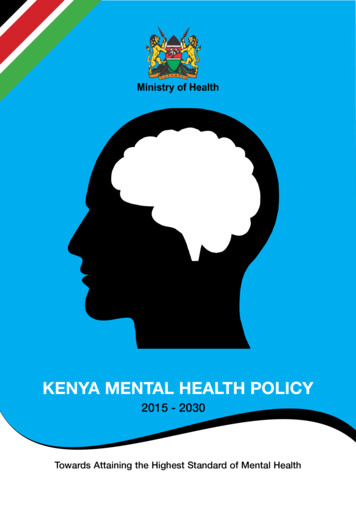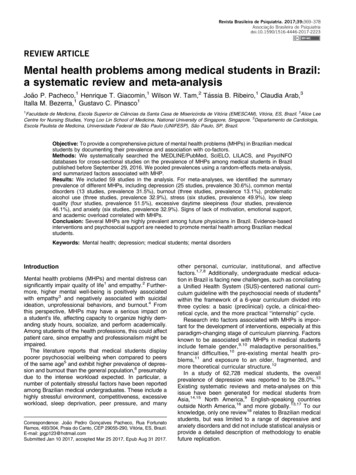
Transcription
Revista Brasileira de Psiquiatria. 2017;39:369–378Associac ão Brasileira de Psiquiatriadoi:10.1590/1516-4446-2017-22230 0 0 0 -0 02-7316-1 85REVIEW ARTICLEMental health problems among medical students in Brazil:a systematic review and meta-analysisJoão P. Pacheco,1 Henrique T. Giacomin,1 Wilson W. Tam,2 Tássia B. Ribeiro,1 Claudia Arab,3Italla M. Bezerra,1 Gustavo C. Pinasco11Faculdade de Medicina, Escola Superior de Ciências da Santa Casa de Misericórdia de Vitória (EMESCAM), Vitória, ES, Brazil. 2Alice LeeCentre for Nursing Studies, Yong Loo Lin School of Medicine, National University of Singapore, Singapore. 3Departamento de Cardiologia,Escola Paulista de Medicina, Universidade Federal de São Paulo (UNIFESP), São Paulo, SP, Brazil.Objective: To provide a comprehensive picture of mental health problems (MHPs) in Brazilian medicalstudents by documenting their prevalence and association with co-factors.Methods: We systematically searched the MEDLINE/PubMed, SciELO, LILACS, and PsycINFOdatabases for cross-sectional studies on the prevalence of MHPs among medical students in Brazilpublished before September 29, 2016. We pooled prevalences using a random-effects meta-analysis,and summarized factors associated with MHP.Results: We included 59 studies in the analysis. For meta-analyses, we identified the summaryprevalence of different MHPs, including depression (25 studies, prevalence 30.6%), common mentaldisorders (13 studies, prevalence 31.5%), burnout (three studies, prevalence 13.1%), problematicalcohol use (three studies, prevalence 32.9%), stress (six studies, prevalence 49.9%), low sleepquality (four studies, prevalence 51.5%), excessive daytime sleepiness (four studies, prevalence46.1%), and anxiety (six studies, prevalence 32.9%). Signs of lack of motivation, emotional support,and academic overload correlated with MHPs.Conclusion: Several MHPs are highly prevalent among future physicians in Brazil. Evidence-basedinterventions and psychosocial support are needed to promote mental health among Brazilian medicalstudents.Keywords: Mental health; depression; medical students; mental disordersIntroductionMental health problems (MHPs) and mental distress cansignificantly impair quality of life1 and empathy.2 Furthermore, higher mental well-being is positively associatedwith empathy3 and negatively associated with suicidalideation, unprofessional behaviors, and burnout.4 Fromthis perspective, MHPs may have a serious impact ona student’s life, affecting capacity to organize highly demanding study hours, socialize, and perform academically.Among students of the health professions, this could affectpatient care, since empathy and professionalism might beimpaired.The literature reports that medical students displaypoorer psychosocial wellbeing when compared to peersof the same age5 and exhibit higher prevalence of depression and burnout than the general population,6 presumablydue to the intense workload expected. In particular, anumber of potentially stressful factors have been reportedamong Brazilian medical undergraduates. These include ahighly stressful environment, competitiveness, excessiveworkload, sleep deprivation, peer pressure, and manyCorrespondence: João Pedro Gonc alves Pacheco, Rua FortunatoRamos, 493/304, Praia do Canto, CEP 29055-290, Vitória, ES, Brazil.E-mail: jpgp123@hotmail.comSubmitted Jan 10 2017, accepted Mar 25 2017, Epub Aug 31 2017.other personal, curricular, institutional, and affectivefactors.1,7,8 Additionally, undergraduate medical education in Brazil is facing new challenges, such as conciliatinga Unified Health System (SUS)-centered national curriculum guideline with the psychosocial needs of students8within the framework of a 6-year curriculum divided intothree cycles: a basic (preclinical) cycle, a clinical-theoretical cycle, and the more practical ‘‘internship’’ cycle.Research into factors associated with MHPs is important for the development of interventions, especially at thisparadigm-changing stage of curriculum planning. Factorsknown to be associated with MHPs in medical studentsinclude female gender,9,10 maladaptive personalities,9financial difficulties,10 pre-existing mental health problems,11 and exposure to an older, fragmented, andmore theoretical curricular structure.12In a study of 62,728 medical students, the overallprevalence of depression was reported to be 28.0%.13Existing systematic reviews and meta-analyses on thisissue have been generated for medical students fromAsia,14,15 North America,9 English-speaking countriesoutside North America,16 and more globally.13,17 To ourknowledge, only one review18 relates to Brazilian medicalstudents, but was limited to a range of depressive andanxiety disorders and did not include statistical analysis orprovide a detailed description of methodology to enablefuture replication.
370JP Pacheco et al.This study aims to provide a comprehensive insight intoBrazilian medical student mental health, by addressingthe following questions relating to medical students inBrazil: 1) what is the prevalence of MHPs and 2) whichco-factors are associated with MHPs. We hypothesizedthat the most investigated MHPs would be depression,anxiety, and burnout; that clinically significant depressionwould affect a significant proportion of medical students;and that female students would be generally more affected by mental health issues, given this trend in the generalpublic.MethodsWe registered the protocol of this review in the International Prospective Register of Systematic Reviews(PROSPERO; record no. CRD42016048236).19Study selection and data extractionTwo review team members (JPP and HTG) independentlyscreened titles and abstracts, assessed studies for eligibility, and performed data extraction. Any discrepancies instudy selection were resolved through discussion with athird reviewer (GCP). We used the Preferred Reporting Itemsfor Systematic Reviews and Meta-Analyses20 (PRISMA)flow chart to illustrate the study selection process (Figure 1).The data extracted from each study included: study characteristics (e.g., location, sample size), participant characteristics (e.g., mean age, gender), and results for theprevalence of MHPs and factors associated with MHPs.Detailed information on data extraction is provided in theprotocol.19 We requested missing data (such as exactnumber of participants, mean age, and gender) from studyauthors as necessary.Risk of bias assessmentSearchesOn September 29, 2016, one reviewer (JPP) searchedMEDLINE (via PubMed) from 1966 to 2016, SciELO from1909 to 2016, LILACS from 1980 to 2016, and PsycINFOfrom 1927 to 2016. The review team developed a commonsearch strategy, including terms related to Brazil, medicalstudents, mental health, mental disorder, and other relatedterms. The complete search strategy is available from theregistered protocol.19 We did not apply limitations to thesearch. In addition, we manually screened the referencesof the included papers for potential inclusion in the review.Inclusion criteriaWe only included cross-sectional studies that evaluated the prevalence of MHPs amongst medical studentsin Brazil. We included studies if: 1) they were crosssectional; 2) they assessed medical students enrolled inBrazilian medical schools; 3) they reported prevalence ofone or more MHPs. For this review, we defined an MHPas any diagnosable mental disorder or symptom of mentaldisorder (e.g., depression, burnout, suicidal ideation).Exclusion criteriaWe excluded studies if: 1) they included medical studentparticipants with non-medical students in the same group,but provided no subgroup analysis; 2) MHPs were notthe main focus of the questionnaire/diagnostic instrument(e.g., the focus was quality of life); 3) they used instrumentsnot validated for the Portuguese language and for Brazilianpopulations (linguistic and cultural validation was required);or 4) the full study was not available.OutcomesThe primary outcomes for this review were the prevalenceof depression and common mental disorders (CMD). Thesecondary outcomes were the prevalence of other MHPsand factors associated with MHPs.Rev Bras Psiquiatr. 2017;39(4)Two authors (JPP and HTG) assessed reporting of ethicalapproval and appraised the studies using the risk-of-biastool developed by Hoy et al.21 We used this tool becauseit addresses external and internal validity and has highinter-rater agreement.21 We omitted the last item of thetool (‘‘Summary item on the overall risk of study bias’’)because of its subjectivity. We resolved disagreements bydiscussion. We used ratings to generate a quality indexfor the quality-effects22 (QE) meta-analysis.Data synthesis and statistical analysisWe used the Meta-analysis of Observational Studies inEpidemiology (MOOSE) statement23 to guide the reporting of this review.When studies provided appropriate data, we pooled theresults using a random-effects (RE) model, thus reportingthe aggregate prevalence, corresponding p-value, and 95%confidence interval (95%CI). We used double arcsine transformation and normalized prevalence data after pooling andback-transformation.24 We presented the results in forestplots. We also performed a sensitivity analysis to examinewhether use of a QE model22 produced a substantial difference in the results. We investigated the QE modelbecause it accounts for study quality and leads to a distinctlyconservative confidence interval when heterogeneityexists.22 When two or more studies reporting the samemental health problem were based on the same database, we selected only one for the quantitative synthesis, favoring the study that was first published. Weselected this criterion because additional studies havefocused on particular subgroups, which could augmenttheir contribution to the meta-analysis results.We assessed heterogeneity using the I2 statistic. Weconsidered an I2 value of 75 to 100% to represent highheterogeneity.25,26 When at least 10 studies25 wereavailable for a meta-analysis, we investigated heterogeneous results through subgroup analysis and metaregression. For subgroup analyses, we considered thefollowing characteristics: 1) gender; 2) study cycle (theBrazilian medical school years are divided into three
Medical student’s mental health371Figure 1 Flow diagram of study inclusion.cycles of 2 years each); 3) country region where theschool is located; 4) cutoff scores (when we noted variation between studies); 5) symptom severity; and 6) risk-ofbias score. For the meta-regression, we considered:1) proportion of male students; 2) age; and 3) risk-of-biasscore. We divided studies into low (X 0.9) and high(o 0.9) risk of bias. We assessed evidence of publicationbias by Egger’s regression method,27 when at least 10studies were available.25 We performed meta-analysesusing MetaXL version 5.3 (EpiGear International, SunriseBeach, Queensland, Australia), and carried out metaregression and Egger’s regression method using the‘‘metafor’’ function in R software version 3.2.0 (R Foundation for Statistical Computing, Vienna, Austria).ResultsWe included 59 studies28-86 in the qualitative analysis,and 5728-37,39-52,54-86 studies involving a total of 18,015medical students in the quantitative analysis (Table 1). AllRev Bras Psiquiatr. 2017;39(4)
372JP Pacheco et al.Table 1 Selected characteristics of the 59 studies of mental health problems amongst medical students in Brazil included inqualitative analysis of a 2016 systematic review and meta-analysisStudy (date)Region of BrazilStudents (n)Mean age (years)Male (%)Abrão (2008)Aguiar (2009)29Alberton (2013)30Alexandrino-Silva lmeida (2007)32Almeida (2016)33Amaral (2008)34Amorim (2008)78Amorim (2012)35Baldassin (2006)36Baldassin (2008)37Baldassin (2013)38*Baldisserotto (2005)79Baltieri (2015)39Bassols (2008)80Bassols (2014)40Bassols (2015)41Brunch (2009)81Cardoso (2009)42Castaldelli-Maia (2012)43Costa (2010)44Costa (2012)45Costa (2012)46Costa (2014)47Cunha (2009)48Danda (2005)49Di Pietro (2009)50Facundes (2005)51Fiorotti (2010)52Furtado (2003)82Gavioli (2009)53*Guimarães (2005)83Hidalgo 0.4NR41.953.1NRNR50.24138.843.658.2Hirata (2007)55Leao (2011)56Lima (2006)57Loayza (2001)58Macedo (2009)59Moro (2005)60Nicoli (2011)61Pagnin in (2015)63Paro (2010)64Paula (2014)65Porcu (2001)84Rique 46.138.741.155.655.7Rocha (2013)67Santos (2011)68Serra (2015)69Silva (2014)70Silveira (2014)71Souza (2010)85Souza (2005)72Tabalipa (2015)73Tempski (2015)74Torres 41.936.243.45743.947.141.6Vallilo (2011)86Vasconcelos (2015)76Volcan (2003)77SENES40023416522.622NR4434.258.828Mental health problem ered eating patterns/EATDepression/BDI; suicidal ideation/BSI;hopelessness/BHSCommon mental disorders/SRQ-20Burnout syndrome/MBI-HSSDepression/BDIPotentially hazardous alcohol intake/AUDITPotentially hazardous alcohol intake/AUDITTrait anxiety/STAI-TDepression/BDIDepression/BDICommon mental n/BDI; anxiety/BAIStress/LSSIDepression/BDI; trait anxiety/STAI-TLow sleep quality/PSQIDepression/BDICommon mental disorders/SRQ-20Depression/BDIBurnout syndrome/MBI-HSSCommon mental disorders/SRQ-20Common mental disorders/SRQ-20Excessive daytime sleepiness/ESSConcern with body shape/BSQCommon mental disorders/SRQ-20Common mental disorders/SRQ-20Stress/LSSICommon mental disorders/SRQ-20Stress/LSSICommon mental disorders/SRQ-20;excessive daytime sleepiness/ESSDepression/BDIDepression/BDI; anxiety/BAICommon mental disorders/SRQ-20Common mental sive eating/BESDepression/BDI; Anxiety/BAI; excessive daytimesleepiness/ESS; low sleep quality/PSQILow sleep quality/MSQ; ssion/BDILow sleep quality/PSQI; excessive daytimesleepiness/ESSCommon mental disorders/SRQ-20Burnout syndrome/MBI-HSSDepression/BDI; anxiety/BAICommon mental disorders/SRQ-20Potentially hazardous alcohol intake/AUDITDepression/BDI; anxiety/STAIStress/GHQDepression/BDI; anxiety/BAIDepression/BDI; anxiety/STAIObsessive-compulsive disorder/OCI-R;Depression/BDIDepression/BDIAnxiety and depression/HADSCommon mental disorders/SRQ-20AUDIT Alcohol Use Disorders Identification Test; BAI Beck Anxiety Inventory; BDI Beck Depression Inventory; BDI-II Beck DepressionInventory, version II; BES Binge Eating Scale; BHS Beck Hopelessness Scale; BSI Beck Scale for Suicidal Ideation; BSQ Body ShapeQuestionnaire; CW Center-West; EAT Eating Attitudes Test-26; ESS Epworth Sleepiness Scale; GHQ General Health Questionnaire;HADS Hospital Anxiety and Depression Scale; LSSI Lipp’s Stress Symptoms Inventory; MBI-HSS Maslach Burnout Inventory-HumanService Survey; MSQ Mini-Sleep Questionnaire; NE Northeast; NR not reported; OCI-R Obsessive-Compulsive Inventory-Revised;PSQI Pittsburgh Sleep Quality Assessment; S South; SE Southeast; SRQ-20 20-item Self-Report Questionnaire; STAI State-TraitAnxiety Inventory; STAI-T Trait Anxiety Inventory.* Not included in the quantitative synthesis.Rev Bras Psiquiatr. 2017;39(4)
Medical student’s mental healthforest plots are available on request from the authors. Weconducted subgroup analyses for depression and CMD(Tables 2 and 3).Prevalence of mental health problemsDepressionIn an analysis of 25 studies, the summary prevalenceof depression among medical students in Brazil was30.6% (95%CI 24.0-37.7, p p 0.01, I2 97.96%). Table 2reports stratified prevalences of depression.The prevalences of depression were significantly different when using medium (32.9%, 95%CI 28.9-37.2) vs.higher (9.9%, 95%CI 6.5-14.1) cutoff scores. When stratified by symptom severity, aggregate prevalence was23.3% (95%CI 19.3-27.6) for students with mild symptoms, 8.4% (95%CI 5.4-12.0) for moderate symptoms,and 2.1% (95%CI 0.8-4.0) for severe symptoms. For metaregression, only the risk-of-bias score was significant (beta 0.7937, p 0.0092).Common mental disordersCMDs can be translated as an indicator of a nonpsychotic mental disorder,87 evaluated by the 20-itemSelf-Report Questionnaire (SRQ-20). The questionnaireassesses 20 somatic, mood and anxious symptoms. It isnot a diagnostic instrument, but a community screeningtool, and cutoff scores may vary according to the culturalcontext in which it is administered.373The prevalence of CMDs among medical students inBrazil was 31.5% (95%CI 26.1-37.1, p p 0.01, I2 92.67%), based on 13 studies. Simple meta-regressionshowed that both risk-of-bias score (beta 0.4986, p 0.0029) and percentage of male students (beta -0.0100,p o 0.01) were significant, but only the percentage of malestudents was significant when both variables were includedin the regression.We detected minimal variation in cutoff scores forCMD, and severity of symptoms is not reported for CMD.Thus, subgroup analyses were not conducted by thesecharacteristics. When prevalences were stratified byregion, students from the South region of the countryTable 3 Subgroups analyses of prevalence of commonmental disorders among medical students in BrazilSubgroupsStudies (n*)RE model pooledprevalence% (95%CI)GenderFemaleMale7737.1 (30.0-44.4)31.9 (23.8-40.4)Cycle studiedBasicClinicalInternship66637.4 (31.1-43.8)42.8 (35.3-50.3)34.6 (24.5-45.2)Region of BrazilSoutheastSouthNortheast44538.1 (29.5-47.1)21.1 (18.9-23.6)31.5 (26.1-37.1)95%CI 95% confidence interval; RE, random-effects.* n indicates number of studies.Table 2 Subgroup analyses of prevalence of depression among medical students in BrazilSubgroupsStudies (n*)RE model pooled prevalence% (95%CI)1 Severity (score)MildModerateSevere17151623.3 (19.3-27.6)8.4 (5.4-12.0)2.1 (0.8-4.0)2 Cutoff (score) Low (X 4)Medium (X 10 to X 12)High (X 15 to X 20)218451.5 (12.8-89.5)32.9 (28.9-37.2)9.9 (6.5-14.1)3 GenderFemaleMale8826.8 (19.0-35.2)17.0 (12.0-22.5)4 Cycle studiedBasicClinicalInternship95630.9 (16.5-46.8)33.8 (6.6-65.1)29.4 (12.3-48.7)5 Region of -37.7)95%CI 95% confidence interval; RE random-effects.* n indicates number of studies.wThe scores juxtapose between studies using the Beck Depression Inventory (BDI-I or II), e.g., mild severity has been considered by authorsas X 4 to p 9 or X 15 to p 20 points in different studies; the total possible score is 63. Cutoff scores were divided by the review team into low (X 4), medium (X 10 to X 12), and high (X 15 to X -20) out of a possible 63 pointsfor the 24 studies that used the BDI-I or II.Rev Bras Psiquiatr. 2017;39(4)
374JP Pacheco et al.showed a significantly lower prevalence (21.1%, 95%CI18.9-23.6) compared to those from the Southeast(38.1%, 95%CI 29.5-47.15) and Northeast (31.5%, 95%CI 26.1-37.1) regions (Table 3).Other mental health problemsAnalysis of three studies yielded a summary prevalenceof burnout of 13.1% (95%CI 10.2-16.4) among medicalstudents in Brazil. One study reported the prevalenceof current suicidal ideation and hopelessness throughstandardized and validated tools. The prevalences were,respectively, 13.4% and 95.5%.Four studies reported prevalences of trait anxiety(89.6%, 95%CI 43.3-100.00), two of state anxiety(62.1%, 95%CI 0.00-100.00), six of anxiety in a generalsense (32.9%, 95%CI 22.0-44.9), six of stress (49.9%,95%CI 57.8-53.0), and one of obsessive-compulsivedisorder (3.8%). Pooled data from three studies yieldedan aggregate prevalence of problematic alcohol use of32.9% (95%CI 29.3-36.6). The aggregate prevalence oflow sleep quality was 51.5% (95%CI 21.2-81.2, pooleddata from four studies), while that of excessive daytimesleepiness was 46.1% (95%CI 37.7-54.5, pooled datafrom four studies).The prevalence of compulsive eating and disorderedeating patterns was 10.9% and 10.0% respectively (datafrom one study). Disordered eating patterns were moreprevalent among females (17.0%) than males (2.6%).One study investigated concern over body shape, butonly reported prevalences for females (21.1%) and males(9.5%) independently.Factors associated with mental health problemsTo balance the effect of multiple comparisons (see paragraph on limitations, Discussion section) and for ease ofinterpretation, we assessed factors that showed significant correlations in more than one study or those significant after multivariate analyses (Table 4). Femalegender was significantly associated with depression,anxiety, and stress, while male gender was more associated with burnout. Thoughts of dropping out, later stagesof the course, little involvement in leisure activities, lack ofemotional support, and academic overload were correlatedwith MHP.Assessment of publication bias, quality of studies, andsensitivity analysisWe found no significant evidence of publication bias in the25 studies that investigated depression (p 0.0658) orin the 13 studies that investigated CMD (p 0.6542). Wedid not conduct such analyses for the other conditionsbecause too few studies were available.Risk-of-bias tool scores ranged from 5 to 10 out of apossible 10 points (table available on request from theauthors). As noted above, risk-of-bias score was the onlysignificant factor in the meta-regression analysis for depression, while for CMD it was significant on simple metaregression. Studies with low risk of bias tended to reporthigher prevalences of depression (37.4%, 95%CI 27.447.7) and CMD (37.7%, 95%CI 31.0-44.6), than thosewith high risk of bias (30.6% [95%CI 24.0-37.7] andTable 4 Factors associated with mental health problems among medical students in Brazil, according to studies included in a2016 systematic review and meta-analysisPositive association(n), p p 0.05Mental health problemDepressionFemale gender(8)*; desire to switch courses(2)*; later stages of the course(2)*; internship cycle(2)*; clinical cycle(3);dissatisfaction with the course(2); tobacco smoking(2); average (compared to good) academic performance*;difficulties in relationships*, emotional tension*; evening-type preference*; feeling pressured by parents*; havingconcerns over the future*; not having a parent who was a physician*; not participating in social activities*, parentswere physicians*; poor or reasonable physical health*, thoughts of dropping out*; religion other than Catholic*,sedentary life style*; sporadic or rare involvement in leisure activities*; uncertainty about professional future.*Common mentaldisordersNot receiving sufficient emotional support(5)*; difficulty making friends(4)*; thoughts of dropping out(2)*; feelings ofrejection(2)*; academic overload(2)*; few leisure activities(3); financial problems(3); not satisfied with professionalchoice(2); clinical cycle(2); feeling rejected by peers/friends(2); history of psychological treatment(2); sleep patterndisorder*; sedentary life style*; not working*; not having a car*; lack of confidence in acquisition of skills*; feelingsof discomfort in relation to the activities of medical school*; unmatched expectations about the course*; priordiagnosis of mental disorder *; emotional tension and feelings of unhappiness*; long-lasting difficulty askingquestions during classes due to shyness*; arousal during the night*; insomnia*; daytime sleepiness*; less than 7hours of sleep per night*; poor self-evaluation of academic performance*; difficulty initiating sleep*; difficultymaintaining sleep*; falling asleep later*; waking up earlier*; low social interaction.*BurnoutLack of confidence in acquisition of skills(2)*; thoughts of dropping out(2)*; male gender(2); having failedexaminations*; feeling uncomfortable in academic activities*; not seeing coursework as a source of pleasure.*AnxietyFemale gender(3)*; parents were not physicians*; feeling pressured by parents.*StressFemale gender(5); first year of the course*; lower family income*; dissatisfaction with the course*; using escape/avoidance as coping strategy.*Low quality sleepCynicism*; emotional exhaustion.*Excessive onal exhaustion*; decreased academic efficacy*; cynicism.*Depressive symptoms*; first year of the course*; adaptation difficulties.*n number of studies in which the association was found (minimum 1).* Significant after multivariate analysis (logistic regression).Rev Bras Psiquiatr. 2017;39(4)
Medical student’s mental health31.5% [95%CI 26.1-37.1] respectively). However, thedifference was not significant. Sensitivity analysis showedno significant difference between results for the QE model,when compared to the RE model.DiscussionOur findings support those from other parts of theworld,9,13-17 emphasizing how prevalent depression andother mental disorders are among medical students.Among the included studies, more had been publishedfrom 2010-2016 than during the entire preceding decade.This draws attention to the fact that, although these issueshave long been reported, they continue to be common inthe lives of medical students, possibly contributing to thehigh prevalence of MHPs among physicians.88,89We report that a high proportion of Brazilian medicalstudents are suffering from various MHPs. These includepsychological stress, anxiety, depression, sleep patterndisorders, burnout, eating disorders, and potentiallyhazardous alcohol use.The most prevalent mental health problem that fittedthe meta-analysis was trait anxiety (89.6%), indicatingthat most medical students have a considerably permanent tendency to experience anxiety, stress, and worries.90 Yates et al.11 observed, in a retrospective survey,that medical students with a mental health problem weremore inclined to have a pertinent pre-admission mentalhealth history. Moreover, Puthran et al.13 have found atendency of depression prevalence to decline in lateryears of the medical course. These findings suggest thatthe high levels of mental disorders among medicalstudents may not be predominantly due to a toxic learningenvironment, as some authors have argued,7,91 but ratherto the contribution of the characteristics of individualsselected through a highly competitive entrance exam.Other hypotheses are that final-year students might bereceiving more treatment or feeling more fulfillment fromtheir professional choice as they become more in chargeof patient care. In the worst-case scenario, those moreseverely depressed students have already dropped out.This does not mean that students with MHPs should notreceive appropriate support within their higher-educationinstitutions. It is precisely because these high prevalencesare observed that we believe an open, non-stigmatizedcommunication should exist between students and theinstitution, especially during the early years of training.Our analysis showed that depressive symptoms,when stratified by severity, are predominantly mild – anevaluation that was not done in previous reviews.13,17Assessment of symptom severity in depression is basedon the number of symptoms, functional impairment, andsuffering imposed by symptoms.92 Following this construct, which is also used by depression scales,92,93mild depression imposes just the number of symptomsrequired for diagnosis or a few more, and produces onlymild social/occupational impairment.94 It is different fromminor or minimal or subthreshold depression,95 andbenefits from evidence-based treatment (e.g., cognitivebehavioral therapy or interpersonal therapy, alone or incombination with antidepressants96). The extent to which375mild depression symptoms affect the lives of medicalstudents should be investigated in future longitudinal studies. However, our finding is not completely unexpected.Because depression can be a debilitating disorder, onlystudents that were performing academic activities at thetimes of data collection were appraised, making studentsthat dropped out or were absent due to a mental disordernot visible to the study (see paragraph on limitationsbelow).Many MHPs and their correlations intersect, suggesting that they might be coexistent in high-risk groups ofstudents. Female students tended to have higher prevalences of depression and CMD. Additionally, femalegender was associated with mood and anxiety disorders,while male gender was associated with burnout. Similargender differences are also observed in the generalpopulation and in medical students from other parts ofthe world.9,97,98 Modifiable stressors also need to beaddressed to improve well-being. As a recent systematicreview99 revealed, there is no satisfactory evidence thatlearning environment interventions could contribute toimproved mental well-being in medical students; additional high-quality research is needed in this area. Weobserved that signs of lack of motivation (e.g., thoughts ofdropping out, dissatisfaction with the course, decreasedacademic efficacy) and lack of emotional support wereassociated with MHP, as in medical students from othercountries.9 The use of portfolios,100 self-assessments,101and continued mentorship102 in undergraduate medicaleducation could improve students’ engagement and reflection about the course, alleviating sources of distressand helping students perceive their coursework as agratifying activity. A drop in academic performance can bean indicative of a mental disorder. This is a key marker,because academic records are usually easily availableto tutors. Future studies could consider the efficacy ofusing this kind of information to identify students tha
REVIEW ARTICLE Mental health problems among medical students in Brazil: a systematic review and meta-analysis Joa o P. Pacheco,1 Henrique T. Giacomin,1 Wilson W. Tam,2 Ta ssia B. Ribeiro,1 Claudia Arab,3 Italla M. Bezerra,1 Gustavo C. Pinasco1 1Faculdade de Medicina, Escola Superior de Cieˆncias da Santa Casa de Miserico rdia de Vitoria (EMESCAM), Vitoria, ES, Brazil. 2Alice Lee

